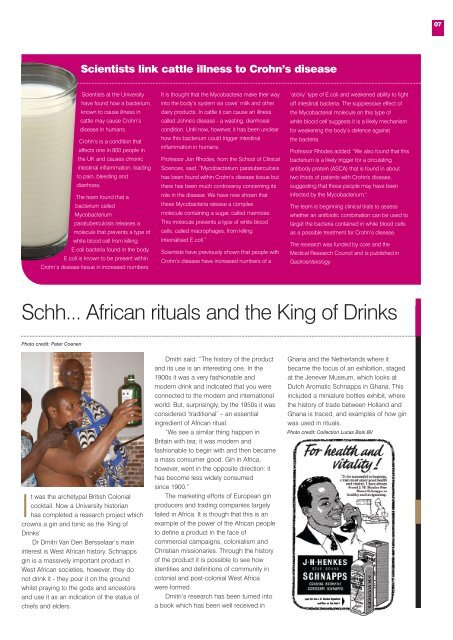Inaugural Lecture Series 2007/08 - University of Liverpool
Inaugural Lecture Series 2007/08 - University of Liverpool
Inaugural Lecture Series 2007/08 - University of Liverpool
Create successful ePaper yourself
Turn your PDF publications into a flip-book with our unique Google optimized e-Paper software.
Scientists link cattle illness to Crohn’s disease<br />
Scientists at the <strong>University</strong><br />
have found how a bacterium,<br />
known to cause illness in<br />
cattle may cause Crohn’s<br />
disease in humans.<br />
Crohn’s is a condition that<br />
affects one in 800 people in<br />
the UK and causes chronic<br />
intestinal inflammation, leading<br />
to pain, bleeding and<br />
diarrhoea.<br />
The team found that a<br />
bacterium called<br />
Mycobacterium<br />
paratuberculosis releases a<br />
molecule that prevents a type <strong>of</strong><br />
white blood cell from killing<br />
E.coli bacteria found in the body.<br />
E.coli is known to be present within<br />
Crohn’s disease tissue in increased numbers.<br />
Schh... African rituals and the King <strong>of</strong> Drinks<br />
Photo credit: Peter Coenen<br />
It was the archetypal British Colonial<br />
cocktail. Now a <strong>University</strong> historian<br />
has completed a research project which<br />
crowns a gin and tonic as the ‘King <strong>of</strong><br />
Drinks’<br />
Dr Dmitri Van Den Bersselaar’s main<br />
interest is West African history. Schnapps<br />
gin is a massively important product in<br />
West African societies, however, they do<br />
not drink it - they pour it on the ground<br />
whilst praying to the gods and ancestors<br />
and use it as an indication <strong>of</strong> the status <strong>of</strong><br />
chiefs and elders.<br />
It is thought that the Mycobacteria make their way<br />
into the body’s system via cows’ milk and other<br />
dairy products. In cattle it can cause an illness<br />
called Johne's disease - a wasting, diarrhoeal<br />
condition. Until now, however, it has been unclear<br />
how this bacterium could trigger intestinal<br />
inflammation in humans.<br />
Pr<strong>of</strong>essor Jon Rhodes, from the School <strong>of</strong> Clinical<br />
Sciences, said: “Mycobacterium paratuberculosis<br />
has been found within Crohn’s disease tissue but<br />
there has been much controversy concerning its<br />
role in the disease. We have now shown that<br />
these Mycobacteria release a complex<br />
molecule containing a sugar, called mannose.<br />
This molecule prevents a type <strong>of</strong> white blood<br />
cells, called macrophages, from killing<br />
internalised E.coli.”<br />
Scientists have previously shown that people with<br />
Crohn’s disease have increased numbers <strong>of</strong> a<br />
Dmitri said: “The history <strong>of</strong> the product<br />
and its use is an interesting one. In the<br />
1900s it was a very fashionable and<br />
modern drink and indicated that you were<br />
connected to the modern and international<br />
world. But, surprisingly, by the 1950s it was<br />
considered ‘traditional’ – an essential<br />
ingredient <strong>of</strong> African ritual.<br />
“We see a similar thing happen in<br />
Britain with tea; it was modern and<br />
fashionable to begin with and then became<br />
a mass consumer good. Gin in Africa,<br />
however, went in the opposite direction: it<br />
has become less widely consumed<br />
since 1900.”<br />
The marketing efforts <strong>of</strong> European gin<br />
producers and trading companies largely<br />
failed in Africa. It is though that this is an<br />
example <strong>of</strong> the power <strong>of</strong> the African people<br />
to define a product in the face <strong>of</strong><br />
commercial campaigns, colonialism and<br />
Christian missionaries. Through the history<br />
<strong>of</strong> the product it is possible to see how<br />
identities and definitions <strong>of</strong> community in<br />
colonial and post-colonial West Africa<br />
were formed.<br />
Dmitri’s research has been turned into<br />
a book which has been well received in<br />
‘sticky’ type <strong>of</strong> E.coli and weakened ability to fight<br />
<strong>of</strong>f intestinal bacteria. The suppressive effect <strong>of</strong><br />
the Mycobacterial molecule on this type <strong>of</strong><br />
white blood cell suggests it is a likely mechanism<br />
for weakening the body’s defence against<br />
the bacteria.<br />
Pr<strong>of</strong>essor Rhodes added: "We also found that this<br />
bacterium is a likely trigger for a circulating<br />
antibody protein (ASCA) that is found in about<br />
two thirds <strong>of</strong> patients with Crohn's disease,<br />
suggesting that these people may have been<br />
infected by the Mycobacterium."<br />
The team is beginning clinical trials to assess<br />
whether an antibiotic combination can be used to<br />
target the bacteria contained in white blood cells<br />
as a possible treatment for Crohn’s disease.<br />
The research was funded by core and the<br />
Medical Research Council and is published in<br />
Gastroenterology.<br />
Ghana and the Netherlands where it<br />
became the focus <strong>of</strong> an exhibition, staged<br />
at the Jenever Museum, which looks at<br />
Dutch Aromatic Schnapps in Ghana. This<br />
included a miniature bottles exhibit, where<br />
the history <strong>of</strong> trade between Holland and<br />
Ghana is traced, and examples <strong>of</strong> how gin<br />
was used in rituals.<br />
Photo credit: Collection Lucas Bols BV<br />
07

















